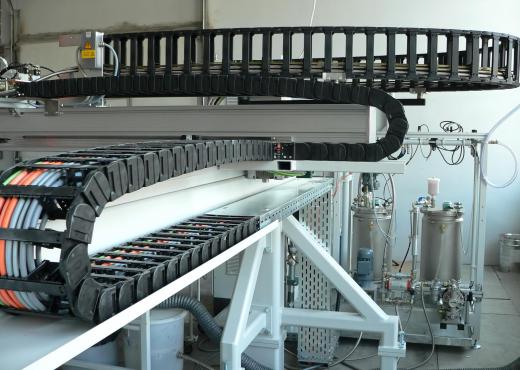There are many types of conveyors that can have vastly differing designs, so the different types of conveyor components depend on the particular application. Traditional belt conveyors consist of a drive mechanism, looped belt, and either rollers or a slider surface to support loads. These conveyors can require some type of take-up to keep the belt taught, and often use scrapers and brushes to clean the surface. Gravity roller conveyor components typically consist of parallel rollers that ride on bearings, though powered roller systems also include chain or belt drives. Other conveyor components include tubes, troughs, vibrating mechanisms, pumps that are used to create a vacuum, and many other specialized parts.
Belt conveyors are one common design that can be relatively simple or very complex depending on the situation. These conveyors consist of at least three different components, which are the belt, the drive mechanism and the load supporting surface. Belts are often made of substances such as rubber or nitrile, though some industrial applications use wire mesh. Drive mechanisms can use chains or belts, and a number of drive pulleys are often used to move the belt along. A take-up pulley is sometimes used to provide tension, and the belt can be supported by a solid slider surface or rollers depending on the items it is designed to transport.

Roller conveyors are another design that can have varying degrees of complexity. One type of roller conveyor system is unpowered and depends on gravity to operate. These devices have relatively few conveyor components, and typically consist of little more than a load bearing frame and a number of parallel rollers. The rollers are usually designed based on the loads they need to carry, so that at least three will support each item at all times. Powered roller conveyors include a few more components, including gears or pulleys at the ends of the rollers that are either chain or belt driven.

Other designs use a wide variety of different conveyor components. Pneumatic systems use tubes and some type of mechanism that is capable of creating a vacuum or that uses compressed air. Some of these systems are capable of both pushing and pulling items through enclosed spaces. Another type of conveyor consists of little more than a trough, and some type of vibrating mechanism that is designed to shake at either a high frequency and low amplitude, or low frequency and high amplitude. With these relatively simple conveyors, the shaking motion is sufficient to move either large or small items depending on the frequency and amplitude of the vibrations.
